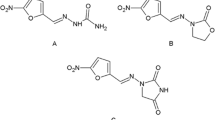Abstract
A new series of pyrrolyl carboxamides, pyrrolyl sulfonamides, and pyrrolyl pyrimidine derivatives were prepared from simple starting compounds—ethyl 3-phenylacrylate and ethyl 3-furanylacrylate under ultrasonication and screened for their antimicrobial activity. Among the tested compounds pyrrolyl pyrimidine derivatives and chloro-substituted pyrroles displayed excellent activity when compared to the other compounds. The chloro-substituted pyrrolyl sulfonamides are the potent antimicrobial agents particularly against P. aeruginosa and P. chrysogenum.
Graphical abstract




Similar content being viewed by others
References
Abele E, Abele R, Lukevics E (2004) Pyrrole oximes: synthesis, reactions, and biological activity (review). Chem Heterocycl Compd 40:1
Anand N (1996) Sulfonamides and sulfones. In: Wolff ME (ed) Burger′s medicinal chemistry and drug discovery, vol 2. Therapeutic agents, 5th edn. Wiley, New York, pp 527–544
Azoro C (2002) Antibacterial activity of crude extract of Azadirachta indica on Salmonella typhi. World J Biotechnol 3:347–357
Bishnu J, Sunil L, Anuja S (2009) Antibacterial property of different medicinal plants: Ocimum sanctum, Cinnamomum zeylanicum, Xanthoxylum armatum and Origanum majorana. J Sci Eng Technol 5:143–150
Cadierno V, Crochet P (2008) Ruthenium-catalyzed furan and pyrrole ring formation. Curr Org Synth 5:343–364
Chegwidden WR, Carter ND, Edwards YH (eds) (2000) The carbonic anhydrases new horizonts. Birkhauser, Basel
Chung KT, Thomasson WR, Wu-Yuan CD (1990) Growth inhibition of selected food-borne bacteria, particularly listeria monocytogenes, by plant extracts. J Appl Bacteriol 69:498–503
Daidone G, Maggio B, Schillari D (1990) Salicylanilide and its heterocyclic analogs. A comparative study of their antimicrobial activity. Pharmazie 45:441–442
Davis FA, Bowen KA, Xu H, Velvadapu V (2008) Synthesis of polysubstituted pyrroles from sulfinimines (N-sulfinyl imines). Tetrahedron 64:4174–4182
Demir AS, Akhmedov IM, Sesenoglu O (2002) Synthesis of 1,2,3,5-tetrasubstituted pyrrole derivatives from 2-(2-bromoallyl)-1,3-dicarbonyl compounds. Tetrahedron 58:9793–9799
French GL (2006) Bactericidal agents in the treatment of MRSA infections—the potential role of daptomycin. J Antimicrob Chemother 58:1107–1117
Janovska D, Kubikova K, Kokoska L (2003) Screening for antimicrobial activity of some medicinal plants species of traditional Chinese medicine. Czech J Food Sci 21:107–110
Kaiser DG, Glenn EM (1972) Correlation of plasma 4,5-bis (p-methoxyphenyl)-2-phenylpyrrole-3-acetonitrile levels with biological activity. J Pharm Sci 61:1908–1911
Leeper FJ, Kelly JM (2013) Synthesis of 3,4-disubstituted pyrroles. A review. Org Prep Proced Int 45:171–210
Leusen AMV, Siderius H, Hoogenboom BE, Leusen DV (1972) A new and simple synthesis of the pyrrole ring system from Michael acceptors and tosylmethylisocyanides. Tetrahedron Lett 13:5337–5340
Maren TH, Chegwidden WR, Carter ND, Edwards YH, (eds) (2000) In the carbonic anhydrases. New Horizons. Birkhauser, Basel, pp 425–436
Meshram HM, Prasad BRV, Kumar DA (2010) A green approach for efficient synthesis of N-substituted pyrroles in ionic liquid under microwave irradiation. Tetrahedron Lett 51:3477–3480
Muralikrishna A, Venkatesh BC, Padmavathi V, Padmaja A, Kondaiah P, Krishna NS (2012) Synthesis, antimicrobial and cytotoxic activities of sulfone linked bis heterocycles. Eur J Med Chem 54:605–614
Neidle S (2001) DNA minor-groove recognition by small molecules. Nat Prod Rep 18:291–309
Padmaja A, Payani T, Reddy GD, Padmavathi V (2009) Synthesis, antimicrobial and antioxidant activities of substituted pyrazoles, isoxazoles, pyrimidine and thioxopyrimidine derivatives. Eur J Med Chem 44:4557–4566
Padmavathi V, Reddy BJM, Sarma MR, Thriveni P (2004) A simple strategy for the synthesis of 3,4-disubstituted pyrroles. J Chem Res 1:79–80
Padmavathi V, Kumari CP, Venkatesh BC, Padmaja A (2011) Synthesis and antimicrobial activity of amido linked pyrrolyl and pyrazolyl-oxazoles, thiazoles and imidazoles. Eur J Med Chem 46:5317–5326
Pavri NP, Trudell ML (1997) An efficient method for the synthesis of 3-arylpyrroles. J Org Chem 62:2649–2651
Scozzafava A, Owa T, Mastrotorenzo A, Supuran CT (2003) Anticancer and antiviral sulfonamides. Curr Med Chem 10:925–953
Sugrue MF (1989) The pharmacology of antiglaucoma drugs. Pharmacol Ther 43:91–138
Sugrue MF (1997) New approaches to antiglaucoma therapy. J Med Chem 40:2793–2809
Supuran CT, Scozzafava A (2001) Endocrine metabolic agents. Curr Med Chem Immunol 1:61–97
Supuran CT, Scozzafava A (2002) Applications of carbonic anhydrase inhibitors and activators in therapy. Expert Opin Ther Patents 12:217–242
Villanova PA (1992) National committee for clinical laboratory standards, reference method for broth dilution antifungal susceptibility testing of yeasts, proposed standard NCCLS document M27–P
Villanova PA (1993) National committee for clinical laboratory, standards methods for dilution antimicrobial susceptibility tests for bacteria that grow aerobically approved standard, 3rd ed. NCCLS Publication M7–A3
Wemmer DE (2001) Ligands recognizing the minor groove of DNA: development and applications. Biopolymers 52:197–211
Acknowledgments
One of the authors A. Padmaja is grateful to CSIR, New Delhi, India for financial assistance under major research project. The authors are also thankful to Prof. D. V. R. Sai Gopal, Department of Bio-Chemistry (SVU), for Biological Activity.
Author information
Authors and Affiliations
Corresponding author
Rights and permissions
About this article
Cite this article
Syamaiah, K., Mallikarjuna Reddy, G., Padmavathi, V. et al. Synthesis and antimicrobial activity of some new amido/sulfonamido-linked 3,4-disubstituted pyrroles. Med Chem Res 23, 3287–3297 (2014). https://doi.org/10.1007/s00044-014-0908-1
Received:
Accepted:
Published:
Issue Date:
DOI: https://doi.org/10.1007/s00044-014-0908-1




